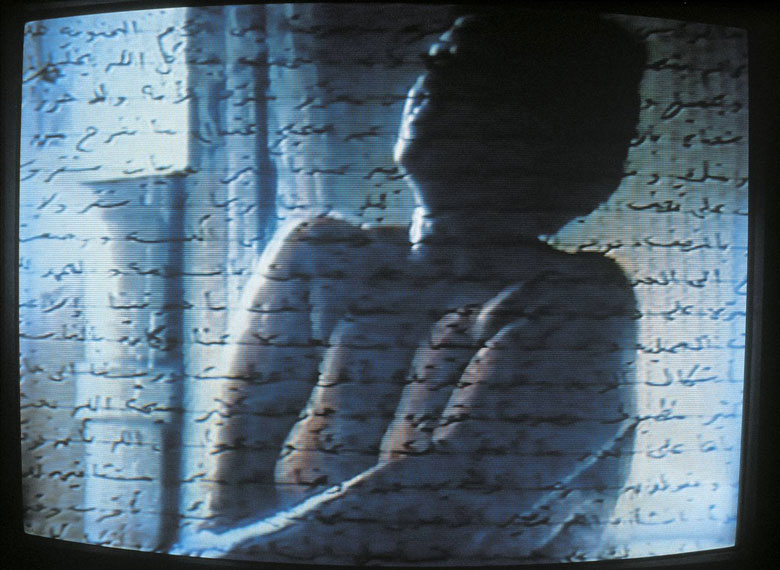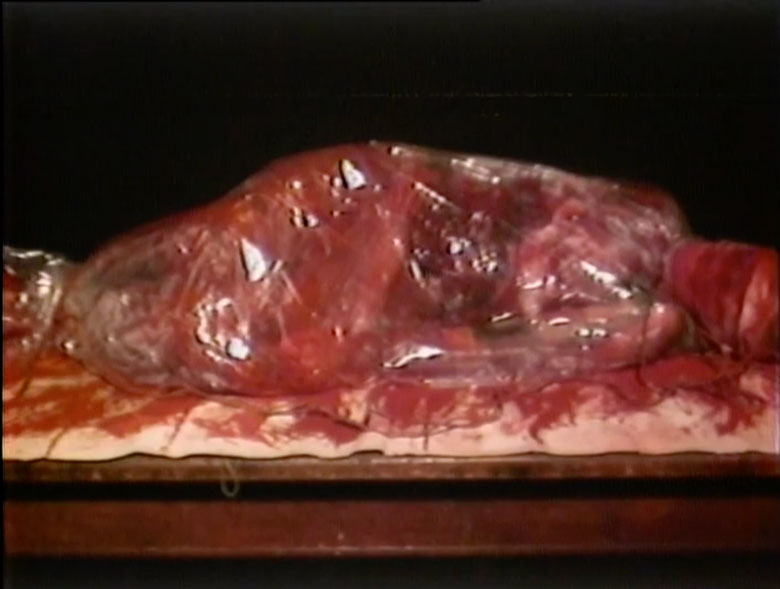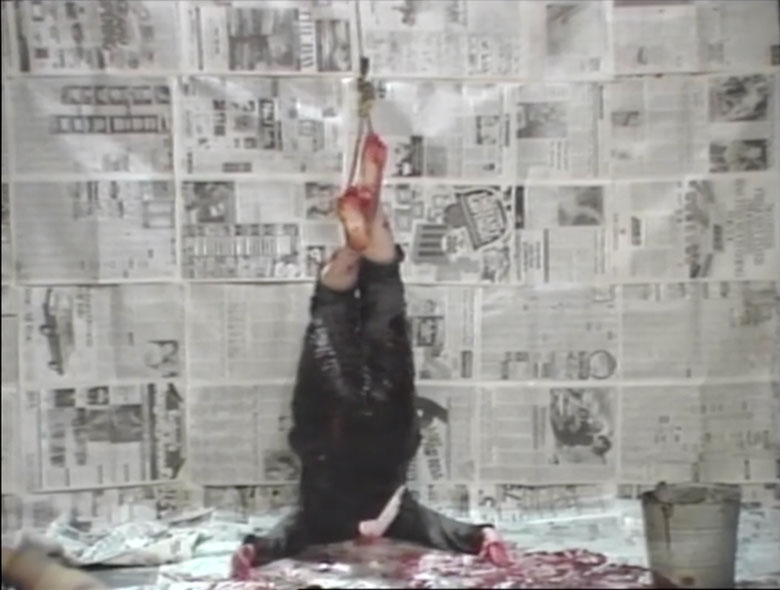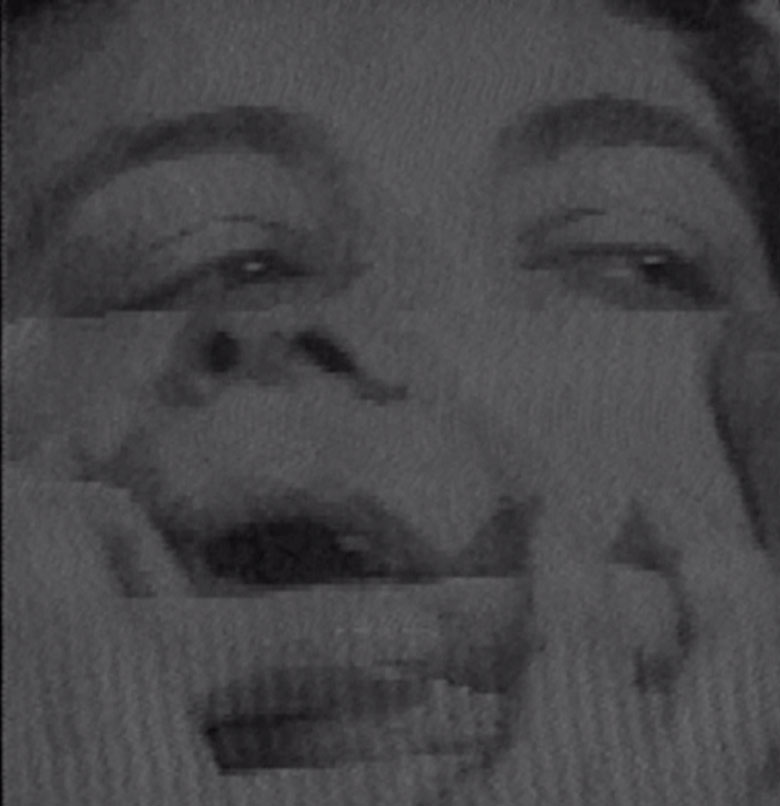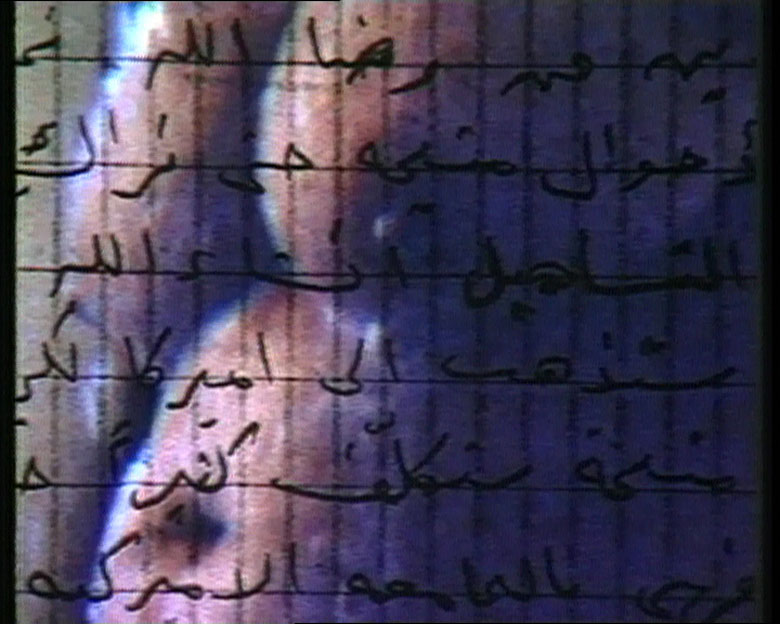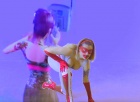In Mona Hatoum’s Barbs and Borders: The Negotiating Table, a video created at the Western Front in Vancouver in 1983, the body is stripped of its skin to focus upon viscera. In the opening shot, the viewer sees a bloody, dark red, disgusting, and gooey surface, as if the inside of the body has been revealed. A clear, transparent plastic sheet covers the body, as if it were a translucent skin that allows the viewer to see inside the body. In Hatoum’s video, the skin becomes fragmented as sections appear to have been peeled away to reveal exposed flesh.
The realisation that the movement of this mass of bloody flesh in the video is caused by breathing is very disturbing. In the initial close-up shots, patches of pink skin become identifiable underneath the heaving mass of viscera. Suddenly, a hand becomes apparent, seemingly disembodied, framed by what looks like entrails. Despite the initial shock of the hand’s seeming disembodiment, one rationalises that it must still be attached because the body is breathing. It is not until several minutes into the video that the camera pans out to reveal an entire body laying on the table, with its feet sticking out from the plastic sheet.
In the 1980s Hatoum created a series of videos at the Western Front that greatly informed the themes of her later artistic practice including fragmentation of skin, issues of violence, visceral qualities of video and viewer interaction, intimacy and distance, and transforming the boundaries of the body. Hatoum created six videos during three residencies at the Western Front: Bars, Barbs and Borders: The Negotiating Table and So Much I Want to Say in 1983; Changing Parts and Variations on Discord and Divisions in 1984; and Measures of Distance and Eyes Skinned in 1988. While authors have cited these videos as being produced at the Western Front, the importance of Hatoum’s Vancouver residencies and the impact of the exploration of the themes in her early videos upon her later installations have been underestimated, if not entirely overlooked.
As part of a generation of women artists whose art production followed after second wave feminism, Hatoum’s works are continuations and re-inscriptions of the concerns of an earlier generation of feminists who presented their own bodies in video and performances to question spectatorship and to disrupt the idea of woman as object. Hatoum states, “Feminism has had a tremendous impact on the art world since the beginning of the seventies. I feel that examining power relationships along the gender divide also paved the way to questioning other power structures along the lines of race, class, and cultural difference.”1
Hatoum’s works are continuations and re-inscriptions of the concerns of an earlier generation of feminists who presented their own bodies in video and performances to question spectatorship and to disrupt the idea of woman as object.
Although the connection has also yet to be explored in any depth, Hatoum’s collaboration with Canadian artist Kate Craig, one of the founders of the Western Front, was pivotal in the development of the themes and experimental video techniques she created during her residencies. Craig oversaw the artist residencies at the Western Front and was directly involved in the production of Hatoum’s videos. In Craig’s most well known video, Delicate Issue (1979), she asks a number of questions in Delicate Issue: “How close can the camera be? What is the dividing line between public and private? How real do you want me to be? Does intimacy breed obscurity? At what distance does the subject read? When do you cut out? When do I cut out? How close do you want to be? Who is willing to watch the frame?”2In this video, Craig explored much of the same terrain as Hatoum’s early video and performance work.
During the 1970s, the first decade of video art, video often sought to create an alternative viewing experience to that of television or cinema spectatorship. Craig’s Delicate Issue was created within the burgeoning feminist artistic practices in the Canadian centres where video was just beginning to be produced.3Writing about video art in English Canada, video historian Dot Tuer states: “As a cultural critique that questioned mechanisms of objectification and structures of representation itself, feminism’s collision with alternative video practices brought into sharp relief issues of spectatorship, presence/absence binaries, and sexual difference.”4In Craig’s video, the artist’s body is seen from close up with an emphasis on skin that is scarred, blemished or freckled, a real, lived female bodies that sweats and is marked by life experiences. This type of feminist inquiry about embodiment is taken up and transformed by Hatoum.
In Hatoum’s video Variations on Discord and Divisions, created at the Western Front in 1984, the boundary between the inside of the body and the outside is breached. The twenty-eight minute video documents a performance by Hatoum at the Western Front on December 14, 1984. During the performance, Hatoum covers a table with white plates and then takes out bits of viscera from inside the cover-alls she wears, cuts them into smaller pieces, and places them onto the plates. At the end of the performance, she serves the plates to members of the audience. The inside of the body becomes externalised and the audience is asked to metaphorically feast on the body of artist.
In both Variations on Discord and Divisions and Barbs and Borders: The Negotiating Table, images of the inside and outside of her body dismantle the divide between private and public, the performer and the audience. In many of her videos Hatoum also situates the body as a site for trauma. In The Negotiating Table, she covered herself in animal blood and viscera. A red liquid, which looks like dried blood, stains the canvas upon which the artist lies. Although the perception of fragmentation in the initial close-up shots is gruesome, the revelation of the entire body is even more unsettling. A spotlight over the table, the rope tied around her feet, and the bandages around her head evoke torture methods. The spotlight also reveals three empty chairs that surround the table, standing in for the absent bodies of the torturers.
The video includes a soundtrack of news reports about the invasion of Lebanon in June 1982 and negotiations amongst Western leaders, which furthers a link between the performance and the traumas of war. Hatoum says of The Negotiating Table, “Alongside the bloody chaos depicted, the detached reportage that attempts to account for it in ordered terms was absurdly disembodied.”5Hatoum creates a negative experience of sound, one that washes over the viewer, eliciting a disturbing feeling.
The soundtrack is a bombardment of sound with the inclusion of white noise that hurts one’s ears. You have to strain to pick out the words as they become blurred together in this mass of sound.
“Feminism has had a tremendous impact on the art world since the beginning of the seventies. I feel that examining power relationships along the gender divide also paved the way to questioning other power structures along the lines of race, class, and cultural difference.”
Eyes Skinned (1988), also produced at the Western Front, again employs images of a fragmented body to address issues of violence and brutality. The ten-minute video begins with a face covered in a black shroud and a soundtrack of someone breathing. A pair of hands covers the face. Images of dead bodies and violence are projected onto the surface of the shroud. As in The Negotiating Table, a soundtrack of news reports crackles, this time in both English and Arabic. The appearance of death created by the shroud over the face is negated by the sound of breathing. The title itself suggests a particularly brutal act. A hand takes a knife and scratches at the surface of the cloth that covers the eyes but never punctures the cloth.
Variations on Discord and Divisions also alludes to bodily harm, violence, and bloodshed. In one segment, dressed in grey cover-alls, her head covered in a black mask, Hatoum washes the floor covered in newspapers with what appears to be blood. She then crawls across the bloody floor towards the audience. The image of the knife upon the black mask portrayed in Eyes Skinned first appears in this video. However, in this video, the knife pierces the cloth to reveal Hatoum’s eyes and mouth. She tapes a large masking tape X on her back, furthering position herself as a target for violence. Unlike a number of early feminist performance works, such as Gina Pane’s Azione sentimentale (1973) where the artist cut into her skin with razor blades and pierces it with thorns, and Ana Mendieta’s performance Untitled (Body Tracks) (1974), where she smeared blood tracks across a canvas, Hatoum does not inflict harm upon her own body but only suggests violence.6
Hatoum’s So Much I Want to Say (1983) fragments the body through the devices of the close-up and remote viewing. The video documents a live performance at the Western Front that was transmitted to Vienna through a Slowcan video and telephone music exchange. A pair of male hands covers Hatoum’s face. She struggles to remove the smothering hands with her own hands, by twisting her head and at times biting the fingers. But her struggle is in vain. The soundtrack, a repetition of the phrase “So much I want to say” drones on and on, reinforcing Hatoum’s struggle as a futile exercise.7The claustrophobic framing device of a series of close-ups creates a visceral response, a feeling of fear and unease in the pits of your stomachs, as if watching a crime that you cannot do anything about it.
Hatoum’s better-known, and much discussed, video created at the Western Front is Measures of Distance from 1988. This sixteen-minute video explores Hatoum’s relationship with her mother through a series of letters, photographs, and recorded discussions that took place during a visit the artist made to Beirut, where her mother lives. The video begins with blurred images that slowly become identifiable as specific body parts while it progresses. Arabic writing extracted from her mother’s letters is superimposed upon the images in well-defined lines. The video includes two soundtracks: Hatoum reading her mother’s letters out loud and their discussions, which include much laughter. The viewer who does not speak Arabic is distanced at first by a language barrier – the recordings of discussions between Hatoum and her mother during the visit are not translated – then by the writing that overlays the images, and finally by the blurring and ambiguity of the images themselves. The mother’s skin is enveloped in language, culture and personal history. The writing acts to veil the body, or crisscross it as if it were barbed wire. The lines on the writing paper enhance the perception of barbed wire symbolic of the state of exile in which her mother lives, separated from her family, and particularly Hatoum and her other daughters.8
The notion of distance is examined by Hatoum on several levels: both conceptually, in terms of exile and estrangement, and visually, by employing photographs of her mother’s body both as close-up fragments and full body images. Measures of Distance also examines emotional and geographic distance. Through the reading of the mother’s letters one becomes of aware of the complex nature of the mother-daughter relationship. The video oscillates between intimacy and distance, both physical and emotional. The personal narrative related through the letters makes one privy to someone else’s private world. Statements read from the letters, such as that the mother wishes to keep secret from the father the fact that Hatoum will use the nude photographs of her in her artwork, bring to the fore that the viewer is seeing into an intimate relationship. This access to images of Hatoum’s mother seems somewhat illicit. Indeed, her mother writes that Hatoum’s father “still nags me about it, [the photography session] as if I had given you something that only belongs to him…it is as if you had trespassed on his property.”9
...the mother wishes to keep secret from the father the fact that Hatoum will use the nude photographs of her in her artwork...her mother writes that Hatoum’s father “still nags me about it, [the photography session] as if I had given you something that only belongs to him…it is as if you had trespassed on his property.”
One becomes completely engaged in the stories told, and the images seem to take a back seat to them. It is as though the reading of the letters is the primary layer, becoming somehow closest to the viewer. This also occurs visually, as the letters are layered on top of the other images. Many of the blurry photographs are close up shots of particular areas of Hatoum’s mother’s body, especially repeated photographs of her breasts and stomach. One hears only snippets of their lengthy conversations and small edited parts of the letters, just as one experiences through the letters small parts of the artist’s and her mother’s lives. As the video progresses the viewer oscillates between thinking the voice is Hatoum’s and her mother’s at the same time. Through this device, the mother and daughter become interchangeable: intimately linked and intertwined. This also occurs through the translation and reading of her mother’s letters by the artist. Distance is measured by the exile that leads to fragmentation of families, communities and nations.
Stories of violence in Beirut punctuate the narrative and ultimately disrupt the communication between mother and daughter. Her mother writes about “This terrible war that seems to go on forever” and “I have not be able to send you any letters for the last few months because the local post office was completely destroyed by that car bomb back in April and there is no sign of them fixing it…There are always rockets falling on the main road.”10At this point in the narrative, the screen turns to black and the video ends.
Hatoum’s videos produced at the Western Front create a strong visceral response in the viewer. I involuntarily shuddered as the knife skims the cloth in Eyes Skinned. I became nauseated when looking at the viscera in The Negotiating Table and Variations on Discord and Divisions. I felt physically fearful and my breath became laboured while watching So Much I Want to Say. I cried the first time I saw Measures of Distance. The movement of the camera in Hatoum’s videos, at times jerky and constantly moving in and out of focus also create a destabilising and disturbing sensation. In Measures of Distance, the close-up shots and the blurring of the maternal body not only create an act of viewing skin as if one were touching it but also fragments the body.
Hatoum’s early videos investigate what Jennifer Fisher describes as “the corporeality of aesthetic processes.”11An awareness of one’s own corporeality quickly turns to alienation when watching the images of the bodies in Hatoum’s videos. It seems unbelievable that the inside of one’s body actually looks like that. One is necessarily alienated from the myriad of internal functions that occur within us that we cannot feel. Despite the flatness of the two dimensional image, the capacity of video to show the body in real time, as a moving, breathing entity creates a corporeal interaction between viewer. The direct relationship created between viewer and artwork is enhanced by video’s ability to focus upon small parts of the body, be it patches of skin or sections of the inside of the body, which allows for a concentrated analysis of a particular fragment.
One might suppose that the fragmentation of the body creates a disconnection between viewer and object so that the viewer is unable to relate the videos to their own bodies. I would argue that the opposite is the case. Fragmentation can enable greater viewer interaction. Fragmentation of the body is not simply a matter of framing, in which video has the capacity to focus on one part at a time. One is continually aware that the rest of the body exists outside of the frame. By calling upon an embodied response, these video works remind one of the simple statement in a 1994 sculpture by Hatoum where on a mirror are engraved three words: “You are still here.”
Rather than a passive experience, Hatoum’s videos produced at the Western Front invite self-reflection as an inter-subjective encounter. Her videos scan the surface of the body to explore its vulnerability, fragility, and yet resilience. Hatoum disrupts the viewing experience by make the viewers question what they are watching, and how they watching, perceiving and interacting with these fragmented bodies. Hatoum notes in her 1981 performance Look No Body!: “It’s just that I often wonder where my body ends…I mean what my boundaries are…whether it’s the skin…what about things like hair and nails, and you know, things that come out of the body in the form of urine, faeces, blood…where does it all end?”12
For a discussion of Kate Craig’s Delicate Issue, see my previous article in Luma Quarterly: https://www.lumaquarterly.com/index.php/issues/volume-four/016-spring/how-real-do-you-want-me-to-be-kate-craigs-delicate-issue/
To learn more about the Western Front: https://front.bc.ca

